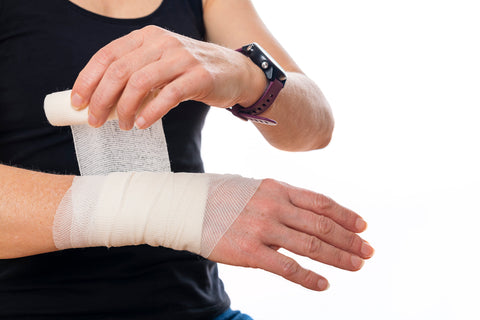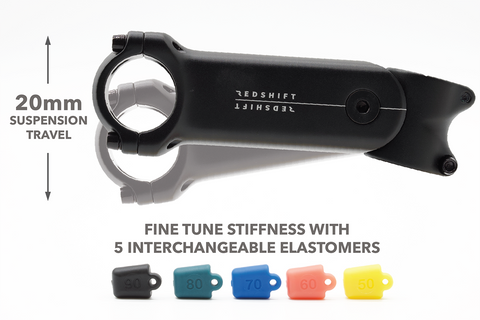Cycling is a rewarding and invigorating activity enjoyed by millions worldwide. However, for some cyclists, wrist pain can be a discouraging obstacle. Whether you're a weekend warrior or a daily commuter, understanding the causes of wrist discomfort while cycling and implementing preventive measures can significantly enhance your riding experience. In this comprehensive guide, we'll explore the various factors contributing to wrist pain and cyclist’s palsy and provide detailed insights into preventive measures to keep you pain-free on your rides.
Understanding Cycling Wrist Pain: Causes and Risks
Wrist pain is a common complaint among cyclists and can arise from several factors. Also known as handlebar palsy or ulnar neuropathy, most wrist pain from cycling is a type of nerve compression syndrome that affects the ulnar nerve in the wrist and hand. Prolonged pressure on the ulnar nerve, often due to gripping the handlebars too tightly, can lead to numbness, tingling, or pain in the hand and fingers. Cyclist Palsy has a number of causes, including:
- Poor Bike Fit: Incorrect bike fit can contribute to wrist pain by causing excessive pressure on the wrists and hands. Issues such as improper saddle height, handlebar reach, or stem length can affect riding posture and lead to discomfort.
- Improper Hand Positioning: Gripping the handlebars too tightly or placing excessive weight on the wrists can strain the muscles and nerves, leading to discomfort and fatigue over time.
- Road Vibrations: Cycling on rough terrain or bumpy roads can transmit vibrations through the handlebars, causing stress on the wrists and hands.
- Inadequate Suspension: Bikes without proper suspension systems or rigid frames can transfer shock directly to the rider, exacerbating wrist pain, especially on uneven surfaces.

Preventing Wrist Pain While Cycling: Effective Strategies
-
Optimal Bike Fit:
- Professional Bike Fitting: Consult with a professional bike fitter to ensure your bike is properly fitted to your body proportions. Adjustments to saddle height, handlebar reach, and stem length can alleviate pressure on the wrists and promote a more comfortable riding position.
- Saddle Height: Set the saddle height so that your leg is almost fully extended at the bottom of the pedal stroke, allowing for proper weight distribution and reducing strain on the wrists.
-
Handlebar Reach and Angle: Experiment with different handlebar positions to find the most comfortable one for your wrists. You may need to consider handlebars designed for the type of riding that you are doing, such as gravel bars. Raising or lowering the handlebars and adjusting their angle can help reduce strain and promote a neutral wrist position.
-
Handlebar Grips
-
Ergonomic Grips: Invest in ergonomic handlebar grips with padded cushioning and contoured shapes to provide adequate support and reduce pressure on the palms and wrists. Gel or foam grips can help absorb road vibrations and minimize discomfort during long rides.
-
Suspension Systems:
- Front Suspension Fork: Upgrade to a bike with a front suspension fork or adjust the suspension settings to match your riding style and terrain. A well-tuned suspension system can absorb shocks and vibrations, reducing the impact on your wrists and hands.
- Shock-Absorbing Stems: Consider installing a suspension stem with built-in elastomers or springs to dampen vibrations and provide a smoother ride. Suspension stems can help alleviate wrist strain, especially on rough terrain or gravel roads. Redshift offers two Suspension Stems, the ShockStop Stem and ShockStop PRO Stem, which both have 20mm range of travel to provide dampening and a more comfortable ride.
- Adjustability: Look for stems with adjustable stiffness settings to fine-tune the level of suspension based on your preferences and riding conditions.
- Relaxed Grip: Maintain a relaxed grip on the handlebars, keeping your wrists in a neutral position rather than hyperextending or locking them. Focus on distributing your weight evenly between your hands, arms, and core to reduce pressure on the wrists
-
Hand Positioning and Grip:
- Correct Hand Placement: Maintain a relaxed grip on the handlebars with your wrists in a neutral position. Avoid gripping the handlebars too tightly, as this can lead to unnecessary strain on your wrists.
-
Alternate Hand Positions: Switching between different hand positions during your ride can help alleviate pressure on specific areas of your wrists. Utilize the drops, hoods, and tops of your handlebars to distribute weight and provide relief to your wrists
Try Flared Handlebars for Better Grip Positions
-
- Padded Gloves: Invest in cycling gloves with gel or foam padding in the palm area to provide additional cushioning and reduce pressure on your wrists. Look for gloves with breathable materials to prevent excessive sweating and discomfort during long rides.
Bike Maintenance:
- Tire Pressure: Ensure your tires are inflated to the recommended pressure levels to provide optimal shock absorption and reduce vibrations transmitted through the handlebars. Lower tire pressure can help absorb bumps and uneven terrain, reducing strain on your wrists.
- Handlebar Tape: Replace worn-out or inadequate handlebar tape with cushioned tape or padded grips to improve comfort and reduce vibrations. Properly wrapped handlebar tape can also provide a more secure grip, reducing the need to grip the handlebars tightly.
Post-Ride Recovery:
- Stretching Routine: Incorporate post-ride stretching exercises to relieve tension in your wrists and forearms. Focus on gentle wrist stretches, forearm stretches, and shoulder rolls to promote relaxation and improve flexibility.
- Ice Therapy: Apply ice packs to your wrists for 10-15 minutes after your ride to reduce inflammation and alleviate any discomfort or swelling. Ice therapy can help soothe sore muscles and promote faster recovery.
Seek Professional Medical Help:
- Physical Therapy: If you experience persistent wrist pain despite implementing preventive measures, consider consulting a physical therapist specializing in sports-related injuries. A physical therapist can assess your riding technique, provide targeted exercises, and recommend additional interventions to address underlying issues contributing to your wrist discomfort.
By incorporating these preventive measures into your cycling routine, you can effectively reduce the risk of wrist pain and enjoy a more comfortable and enjoyable riding experience. Remember that proper bike fit, ergonomic equipment, mindful riding technique, and post-ride recovery strategies are essential for maintaining healthy wrists and maximizing your cycling performance. Don't let wrist pain limit your cycling adventures – take proactive steps to protect your wrists and ride pain-free for miles to come. Happy cycling!

